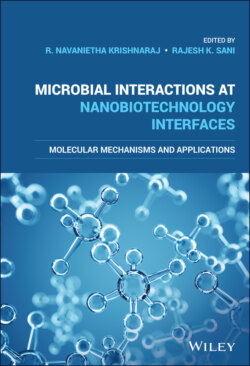Читать книгу Microbial Interactions at Nanobiotechnology Interfaces - Группа авторов - Страница 2
Table of Contents
Оглавление1 Cover
4 Preface
6 1 Shape‐ and Size‐Dependent Antibacterial Activity of Nanomaterials Objectives 1.1 Introduction 1.2 Synthesis of Nanomaterials 1.3 Classification of NMs 1.4 Application of NMs 1.5 Bacterial Resistance to Antibiotics 1.6 Microbial Resistance: Role of NMs 1.7 Antibacterial Application of NMs 1.8 Interaction of NMs with Bacteria 1.9 Antibacterial Mechanism of NMs 1.10 Factors Affecting the Antibacterial Activity of NMs 1.11 Influence of Size on the Antibacterial Activity and Mechanism of Action of Nanomaterials 1.12 Influence of Shape on the Antibacterial Activity and Mechanism of Action of Nanomaterials 1.13 Effects of Functionalization on the Antimicrobial Property of Nanomaterials 1.14 Conclusion and Future Perspectives Questions and Answers References Keywords
7 2 Size‐ and Shape‐Selective Synthesis of DNA‐Based Nanomaterials and Their Application in Surface‐Enhanced Raman Scattering Objectives 2.1 Introduction 2.2 Mechanism of Surface‐Enhanced Raman Scattering (SERS) 2.3 Size‐ and Shape‐Selective Synthesis of Metal NPs with DNA for SERS Studies Questions and Answers Acknowledgements References Academic Profile
8 3 Surface Modification Strategies to Control the Nanomaterial–Microbe Interplay Objectives 3.1 Introduction 3.2 Factors Influencing NM–Microbe Cross talk 3.3 Surface Functionalization 3.4 Characterization of NM–Microbe Interactions 3.5 Toxicity of the Surface‐Modified NMs 3.6 Challenges and Future Perspectives Questions and Answers References
9 4 Surface Functionalization of Nanoparticles for Stability in Biological Systems Objectives 4.1 Introduction 4.2 Major Processes Affecting NP Stability in Biological Media 4.3 Measures to Enhance NP Stability in Biological Systems 4.4 Conclusion and Future Perspectives 4.5 Summary Questions and Answers References
10 5 Molecular Mechanisms Behind Nano‐Cancer Therapeutics Objectives 5.1 Nanotechnology at Nano–Bio Interfaces 5.2 Armory of Nanomedicine at Nano–Bio Interfaces 5.3 Nanoparticle Edge in Modulating Biological Process 5.4 Intracellular Uptake and Trafficking of Nanoparticle 5.5 Challenges in Clinical Applications 5.6 Conclusion Questions and Answers Acknowledgements References
11 6 Protein Nanoparticle Interactions and Factors Influencing These Interactions Objectives 6.1 Introduction 6.2 Types and Biomedical Application of Nanoparticles 6.3 Methods and Mechanisms of Nanomaterials Synthesis 6.4 Routes of Entry of Nanoparticles into Biological System 6.5 Rationale for Studying Nanoparticles–Protein Interactions 6.6 Formation of Protein Corona 6.7 Nanoparticles‐Induced Structural Changes in Proteins 6.8 Factors Influencing Corona Formation 6.9 Interaction of Nanoparticles with Cells and Their Uptake 6.10 Pleiotrophic Effect of Nanoparticles 6.11 Analytical Methods to Study Nanoparticles–Protein Interaction Questions and Answers References
12 7 Interaction Effects of Nanoparticles with Microorganisms Employed in the Remediation of Nitrogen‐Rich Wastewater Objectives 7.1 Introduction 7.2 Bacterial Nitrification Process 7.3 Effect of NPs on Denitrifying Bacteria 7.4 Impact of Nanoparticles on Nitrogen Removal 7.5 Conclusion Take Home Message Questions and Answers Acknowledgements References
13 8 Silver‐Based Nanoparticles for Antibacterial Activity Objectives 8.1 Introduction 8.2 Historical Background of Silver 8.3 Synthesis Procedures of Silver Nanoparticles 8.4 Biological Application of Silver Nanoparticles 8.5 Bacterial Infection and Antibiotic Resistance 8.6 Nanosilver for Antibacterial Therapy 8.7 Influence of Size and Shape of Silver Nanoparticles as Antibacterial Agents 8.8 Nanosilver and Its Mechanism of Action for Antibacterial Therapy 8.9 Application of Silver Nanoparticle in Commercial Products 8.10 Toxicity of Silver Nanoparticles 8.11 Future Prospective and Challenges 8.12 Conclusion Take Home Message Questions and Answers Acknowledgments References
14 9 Microbial Gold Nanoparticles and Their Biomedical Applications Objectives 9.1 Introduction 9.2 Microbial Gold Nanoparticles Synthesis 9.3 Applications of Microbial Gold Nanoparticles 9.4 Conclusion Acknowledgements Take Home Message Questions and Answers References
15 10 Nano‐Bio Interactions and Their Practical Implications in Agriculture 10.1 Introduction 10.2 Engineered Nanomaterials and Agriculture 10.3 Summary References
16 11 Biogeochemical Interactions of Bioreduced Uranium Nanoparticles 11.1 Introduction 11.2 Coupled Biogeochemical Mechanisms and Interactions of U in the Subsurface 11.3 Biogenic Uraninite Precipitation and Its Nanoparticulate Forms 11.4 Re‐oxidation and Stability of Bioreduced Uranium 11.5 Summary and Conclusions Questions and Answers References
17 12 Characterization and Quantification of Mobile Bioreduced Uranium Phases 12.1 Introduction 12.2 Characterization of Biogenic U(IV) 12.3 Quantification of Mobile Bioreduced U(IV) Nanoparticles 12.4 Summary and Conclusions Questions and Answers References
18 Index
